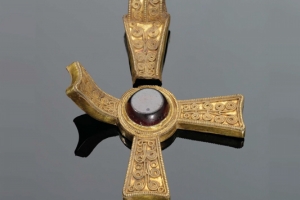Beowulf's Mirror
REFLECTIONS ON THE STAFFORDSHIRE HOARD
Rich in gold and garnets, the contents of the hoard represent a warrior’s kit, covering a period from the sixth to the seventh centuries AD.
Object conservation and research are enabling questions about the Anglo-Saxons and kingdom of Mercia to be answered, but how and why the hoard was hidden in the Staffordshire soil is likely to remain a mystery.
The military and religious fittings of the Staffordshire Hoard were buried together, but they were not originally crafted as one collection. Some of the objects were heavily worn and of considerable age when they were buried, whilst others were newly made. The raw materials and manufactured objects have a broad geographical origin, but presented in context, they are illuminating the material culture and early history of England itself.
The Mercian kingdom is a shadowy beast: historical, archaeological and modern administrative quirks have combined to render it less ‘visible’ to us than its neighbours. We know that by 655 AD, when King Penda was slain at the battle of Winwaed (modern location unknown), Mercia was already an aggressive and expansionist military power that would come to dominate England in the centuries ahead.
KEYWORDS: Staffordshire Hoard, Anglo Saxons, Mercia, Warriors, Beowulf, Art, Gold, Birmingham Museum and Art Gallery, BMAG, Potteries Museum and Art Gallery, Books
Download the Full Article (PDF)Categories:
